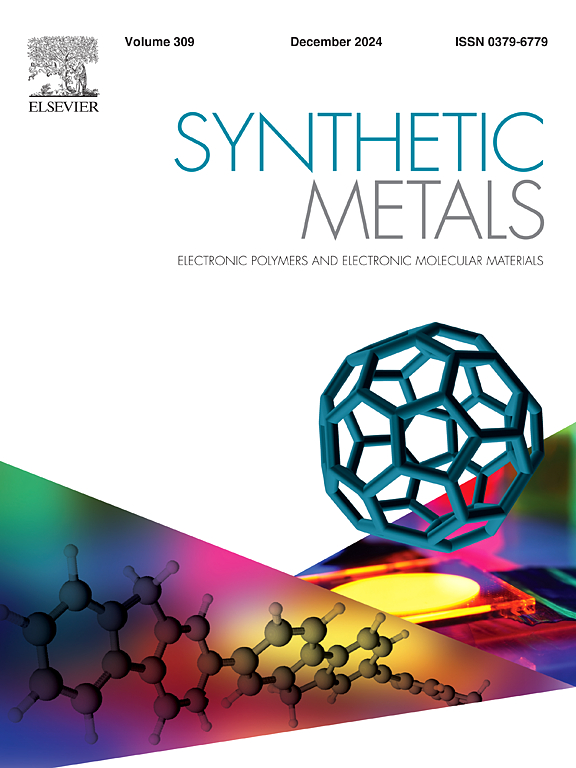Optimizing electrochemical properties of PANI@MoSe₂/Cr₂C for enhanced hydrogen evolution reaction and energy storage in asymmetric supercapacitors
IF 4
3区 材料科学
Q2 MATERIALS SCIENCE, MULTIDISCIPLINARY
引用次数: 0
Abstract
The search for supercapacitors' high-performance electrode materials has sparked a lot of research into innovative hybrid architectures. Supercapattery devices combine the extraordinary power density and cyclic stability of supercapacitors with the high energy density of batteries. This study details synthesized and analyzed of hybrid electrode material consisting of Polyaniline (PANI) deposited on molybdenum di-selenide (MoSe2) and chromium carbide (Cr2C) using the hydrothermal method. XRD, SEM, and XPS confirmed well-defined PANI@MoSe2/Cr2C composites with a high surface area (BET). The hybridization leverages the synergistic effects of the distinct properties of PANI, MoSe2, and Cr2C to enhance electrochemical performance in supercapacitors. PANI@MoSe2/Cr2C showed higher specific capacities (1171 C/g at 10 mV/s) than PANI@MoSe2 (1249 C g−1) and PANI@Cr2C (1578 C g-³) in three-electrode tests. A supercapattery using PANI@MoSe2/Cr2C and activated carbon achieved 72.92 Wh kg-¹ energy density and 400 W kg-¹ power density. It also retained 86.72 % capacity and 90.67 % coulombic efficiency over 12,000 cycles. Dunn's model explained capacitive and diffusive contributions. PANI@MoSe2/Cr2C exhibited efficient Tafel slope of about 40.0 mV/s and low over potential of 101.41 mV are characteristics of HER activity. These characteristics demonstrate PANI@MoSe2/Cr2C's potential as an electrode material for future energy storage applications.
优化PANI@MoSe₂/Cr₂C的电化学性能,增强非对称超级电容器的析氢反应和储能
对超级电容器高性能电极材料的研究引发了对创新混合结构的大量研究。超级电池装置将超级电容器的超高功率密度和循环稳定性与电池的高能量密度相结合。本研究采用水热法合成并分析了由聚苯胺(PANI)沉积在二硒化钼(MoSe2)和碳化铬(Cr2C)上的杂化电极材料。XRD, SEM和XPS证实了具有高比表面积(BET)的PANI@MoSe2/Cr2C复合材料。杂化利用聚苯胺、MoSe2和Cr2C的不同性质的协同效应来提高超级电容器的电化学性能。PANI@MoSe2 / Cr2C显示更高的特定能力(1171 C / g(10 mV / s)比PANI@MoSe2 (1249 C g−1)和PANI@Cr2C(1578 C g -³)三电极测试。利用PANI@MoSe2/Cr2C和活性炭制备的超级电池的能量密度为72.92 Wh kg-¹,功率密度为400 W kg-¹。在12,000次循环中,它还保持了86.72 %的容量和90.67 %的库仑效率。邓恩的模型解释了电容性和扩散性的贡献。PANI@MoSe2/Cr2C表现出约40.0 mV/s的有效塔非斜率和101.41 mV的过电位是HER活性的特征。这些特性证明了PANI@MoSe2/Cr2C作为未来储能应用的电极材料的潜力。
本文章由计算机程序翻译,如有差异,请以英文原文为准。
求助全文
约1分钟内获得全文
求助全文
来源期刊

Synthetic Metals
工程技术-材料科学:综合
CiteScore
8.30
自引率
4.50%
发文量
189
审稿时长
33 days
期刊介绍:
This journal is an international medium for the rapid publication of original research papers, short communications and subject reviews dealing with research on and applications of electronic polymers and electronic molecular materials including novel carbon architectures. These functional materials have the properties of metals, semiconductors or magnets and are distinguishable from elemental and alloy/binary metals, semiconductors and magnets.
 求助内容:
求助内容: 应助结果提醒方式:
应助结果提醒方式:


